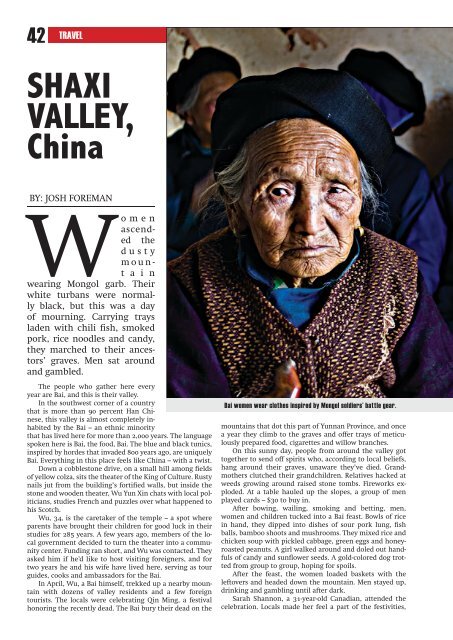AP-2009-07 - Asia-Pacific Business and Technology Report
AP-2009-07 - Asia-Pacific Business and Technology Report
AP-2009-07 - Asia-Pacific Business and Technology Report
- No tags were found...
Create successful ePaper yourself
Turn your PDF publications into a flip-book with our unique Google optimized e-Paper software.
42travelsHaXiValleY,ChinaBy: JOSh FOREMANWo menascendedthedustymounta i nwearing Mongol garb. Theirwhite turbans were normallyblack, but this was a dayof mourning. Carrying traysladen with chili fish, smokedpork, rice noodles <strong>and</strong> c<strong>and</strong>y,they marched to their ancestors’graves. Men sat around<strong>and</strong> gambled.The people who gather here everyyear are Bai, <strong>and</strong> this is their valley.In the southwest corner of a countrythat is more than 90 percent han Chinese,this valley is almost completely inhabitedby the Bai – an ethnic minoritythat has lived here for more than 2,000 years. The languagespoken here is Bai, the food, Bai. The blue <strong>and</strong> black tunics,inspired by hordes that invaded 800 years ago, are uniquelyBai. Everything in this place feels like China – with a twist.Down a cobblestone drive, on a small hill among fieldsof yellow colza, sits the theater of the King of Culture. Rustynails jut from the building’s fortified walls, but inside thestone <strong>and</strong> wooden theater, Wu yun Xin chats with local politicians,studies French <strong>and</strong> puzzles over what happened tohis Scotch.Wu, 34, is the caretaker of the temple – a spot whereparents have brought their children for good luck in theirstudies for 285 years. A few years ago, members of the localgovernment decided to turn the theater into a communitycenter. Funding ran short, <strong>and</strong> Wu was contacted. Theyasked him if he’d like to host visiting foreigners, <strong>and</strong> fortwo years he <strong>and</strong> his wife have lived here, serving as tourguides, cooks <strong>and</strong> ambassadors for the Bai.In April, Wu, a Bai himself, trekked up a nearby mountainwith dozens of valley residents <strong>and</strong> a few foreigntourists. The locals were celebrating Qin Ming, a festivalhonoring the recently dead. The Bai bury their dead on thebai women wear clothes inspired by mongol soldiers’ battle gear.mountains that dot this part of yunnan Province, <strong>and</strong> oncea year they climb to the graves <strong>and</strong> offer trays of meticulouslyprepared food, cigarettes <strong>and</strong> willow branches.On this sunny day, people from around the valley gottogether to send off spirits who, according to local beliefs,hang around their graves, unaware they’ve died. Gr<strong>and</strong>mothersclutched their gr<strong>and</strong>children. Relatives hacked atweeds growing around raised stone tombs. Fireworks exploded.At a table hauled up the slopes, a group of menplayed cards – $30 to buy in.After bowing, wailing, smoking <strong>and</strong> betting, men,women <strong>and</strong> children tucked into a Bai feast. Bowls of ricein h<strong>and</strong>, they dipped into dishes of sour pork lung, fishballs, bamboo shoots <strong>and</strong> mushrooms. They mixed rice <strong>and</strong>chicken soup with pickled cabbage, green eggs <strong>and</strong> honeyroastedpeanuts. A girl walked around <strong>and</strong> doled out h<strong>and</strong>fulsof c<strong>and</strong>y <strong>and</strong> sunflower seeds. A gold-colored dog trottedfrom group to group, hoping for spoils.After the feast, the women loaded baskets with theleftovers <strong>and</strong> headed down the mountain. Men stayed up,drinking <strong>and</strong> gambling until after dark.Sarah Shannon, a 31-year-old Canadian, attended thecelebration. Locals made her feel a part of the festivities,<strong>AP</strong>-2.indd 427/12/09 11:56:18 PM









